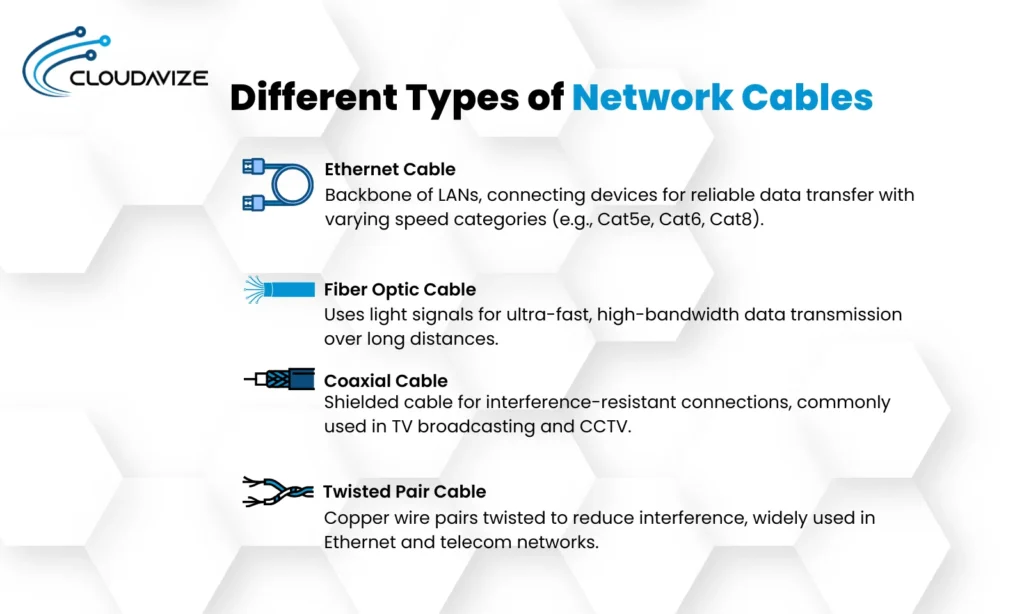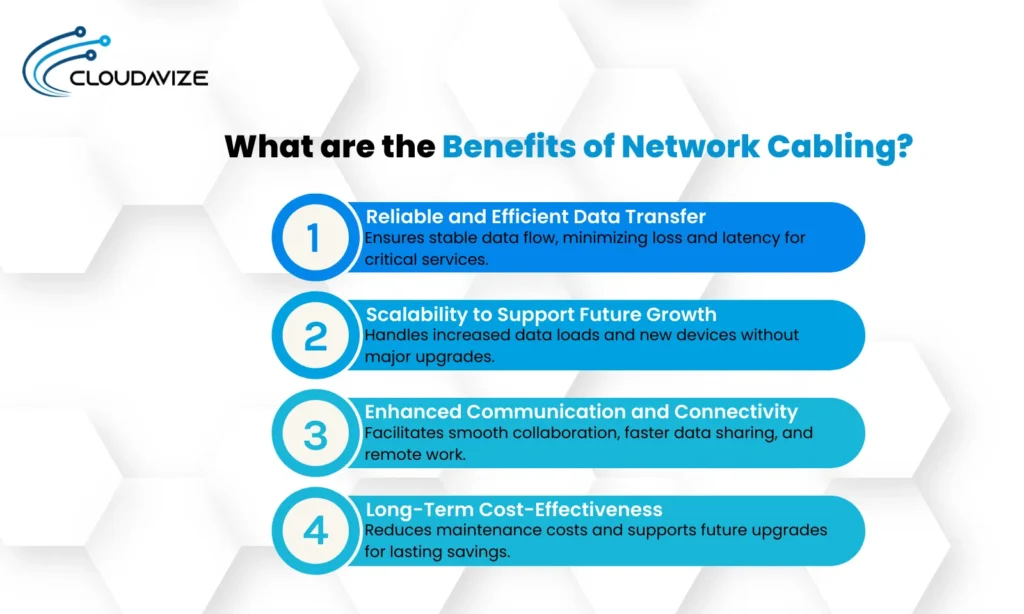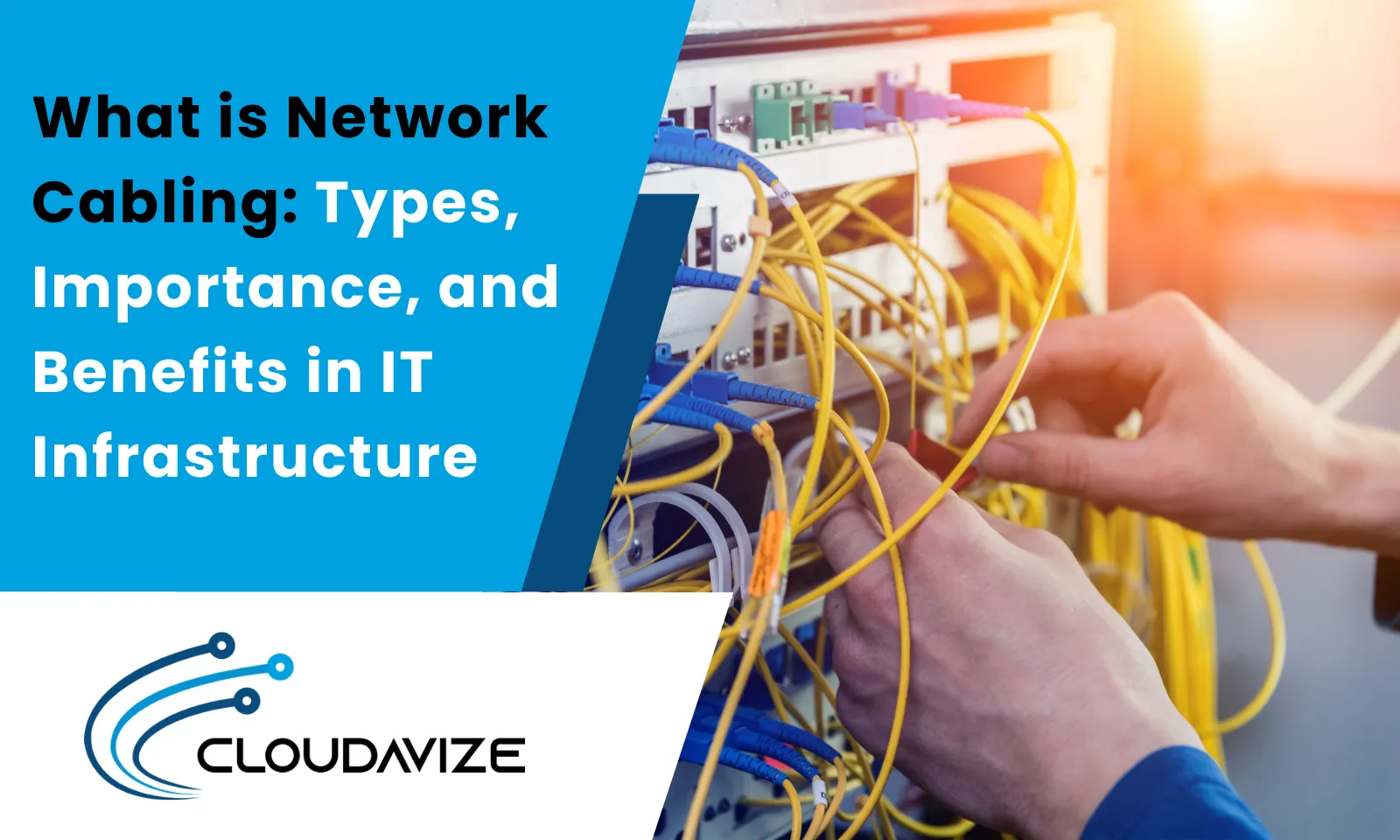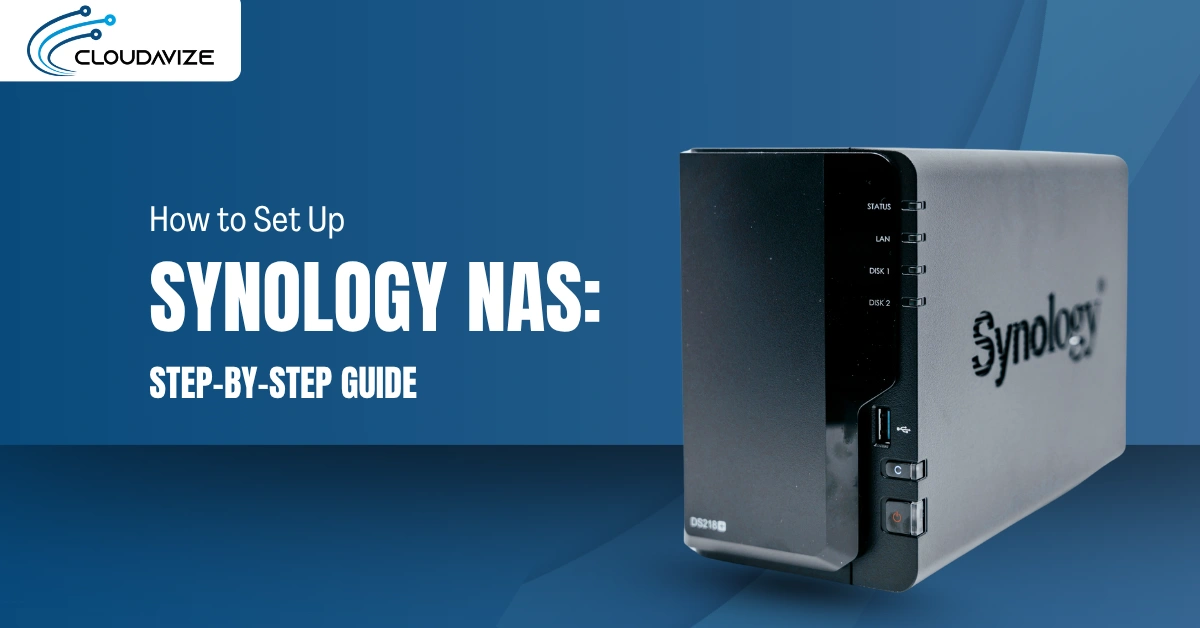Network cabling is the foundation of modern IT infrastructure, ensuring seamless communication, data transfer, and automation across businesses and industries. From video conferencing and cloud computing to IoT integration, a well-structured cabling system delivers high-speed, stable connectivity that keeps operations running smoothly. Choosing the right cables, such as Ethernet, fiber optics, or coaxial, is essential for meeting performance demands and creating an efficient, scalable, and resilient network.
As digital transformation accelerates, the demand for structured cabling continues to surge. According to Precedence Research, the U.S. structured cabling market reached USD 3.33 billion in 2024 and is projected to reach USD 9.50 billion by 2034. This rapid expansion highlights the critical role of cabling in data centers, businesses, and smart buildings. With strategic planning and professional installation, organizations can build a future-proof network that adapts to evolving technology, making structured cabling a foundation for long-term growth and innovation.
Table of Contents
What is Network Cabling?
Network cabling is a structured system of cables that connects devices to a network within an IT infrastructure. It serves as the backbone of modern networking, enabling seamless communication and efficient transmission of data, voice, and video between computers, servers, routers, and switches. A well-planned cabling system ensures efficient data transmission, minimal signal loss, and reliable connectivity, supporting both wired and wireless network operations.
The primary role of network cabling is to connect and integrate various devices, allowing for the smooth exchange of information across a network. Whether in a small office or a large data center, structured cabling enhances network performance, supports high-speed internet access, and ensures uninterrupted business operations. By providing a stable and scalable foundation, network cabling plays a critical role in maintaining an organized and efficient IT environment.
Why is Network Cabling Important in IT infrastructure?
Network cabling is essential for seamless communication between devices, supporting critical operations such as VoIP, video conferencing, cloud computing, and security systems. These services require high-speed and reliable data transfer, which a well-installed cabling system provides. Proper network cabling ensures low latency, high bandwidth, and minimal signal loss, enabling uninterrupted communication and optimal business performance.
A structured cabling system simplifies IT infrastructure by organizing network components into a unified framework. This reduces complexity, minimizes downtime, and improves troubleshooting efficiency, ensuring consistent connectivity. By creating a well-organized network, structured cabling enhances operational efficiency and long-term reliability.
Scalability is another significant advantage of structured cabling. A well-designed system supports future expansions and technology upgrades without major disruptions. It allows businesses to integrate new devices, improve data flow, and adapt to growing network demands without excessive maintenance costs or reconfigurations.
Effective network cabling reduces the risk of network failures, enhances data security, and ensures a stable IT environment. With an optimized cabling system, businesses experience fewer connectivity issues, lower maintenance costs, and improved overall network performance, making it a crucial investment for modern IT infrastructure.
What are the Different Types of Network Cables used?
Network cabling consists of several cable types, including Ethernet cables, fiber optic cables, coaxial cables, and twisted pair cables, each designed for specific applications in data transfer and communication, offering unique advantages. Choosing the right type of network cable depends on factors like network speed, distance, and environmental conditions.

Below are the most commonly used cables in network cabling, along with their specific applications and benefits
Ethernet Cables
Forming the backbone of most local area networks (LANs), Ethernet cables connect devices such as computers, routers, and switches for reliable data transfer. Available in types like Cat5e, Cat6, and Cat6a, they offer varying speeds and bandwidths to suit different network needs. For example, Cat8 cables are designed for high-speed data centers and ultra-fast performance.
Ethernet cables are crucial for applications such as internet access, VoIP, and video conferencing, ensuring stable and secure communication in offices, data centers, and business networks.
Fiber Optic Cable
Offering higher speed and bandwidth than copper-based cables, Fiber optic cables transmit data through light signals. They excel in long-distance, high-performance networks with minimal signal loss, making them critical for high-performance networks.
High-capacity fiber optic types, including multi-core and dense wavelength division multiplexing (DWDM) fibers, are designed for environments with heavy data demands, such as global telecommunication networks and large-scale cloud infrastructure. Their reliability makes them essential for campuses, remote data hubs, and critical communication infrastructure.
Coaxial Cable
Coaxial cables, with their central conductor, insulation, and metallic shielding, provide a durable and interference-resistant solution for specific networking needs. Historically used for early internet and cable TV services, these cables remain relevant in CCTV systems and television broadcasting.
Though less common in modern networking, they are still useful for providing stable internet connections in areas lacking fiber or Ethernet infrastructure. They also help distribute television signals and secure video transmission for surveillance systems.
Twisted Pair Cable
Twisted pair cables consist of copper wire pairs twisted together to minimize electromagnetic interference. Their flexibility, cost-efficiency, and ease of installation have made them a popular choice for Ethernet networks, telecommunication services, local area networks, telephone systems, and CCTV setups. Applications include wired office networks, telephone lines, and security camera connections.
Twisted pair cables are available in two main types: shielded twisted pair (STP) and unshielded twisted pair (UTP).
- Shielded Twisted Pair (STP) Cable
STP cables feature an additional shielding layer that protects against external electromagnetic interference, making it ideal for industrial facilities and medical environments with sensitive equipment.
- Unshielded Twisted Pair (UTP) Cable
UTP cables rely on the twisting of wire pairs to reduce interference without additional shielding. Due to its compatibility with Ethernet devices, ease of installation, and cost-effectiveness, these cables are commonly used in home and office networks, telephone systems, and basic security setups.
What are the Benefits of Network Cabling?
The main benefits of network cabling include reliable data transmission, enhanced connectivity, scalability, and long-term cost savings. A well-structured cabling system ensures efficient communication between devices, reduces network downtime, and supports future growth, making it a crucial component of IT infrastructure.

- Reliable and efficient data transfer:
Structured cabling ensures stable and uninterrupted data flow, minimizing data loss and latency. This reliability supports critical services such as video conferencing, VoIP, and large data transfers. - Scalability to support future growth:
Proper cabling is designed to handle increased data loads and accommodate additional devices without requiring a complete network overhaul. This scalability allows organizations to integrate new technologies as they grow seamlessly. - Enhanced communication and connectivity:
A robust cabling system facilitates smooth communication between devices and systems, enhancing collaboration and productivity. This infrastructure enables faster data sharing, improved internal communication, and reliable remote work solutions. - Long-term cost-effectiveness:
Durable and well-organized cabling reduces maintenance costs by minimizing downtime and simplifying troubleshooting. It also supports future upgrades, ensuring long-term savings by avoiding frequent infrastructure replacements.
Key Consideration of Network Cabling Installation
Proper network cabling installation requires careful planning to ensure optimal performance, reliability, and scalability. Factors such as cable type, network design, compliance standards, and future expansion must be considered to build an efficient and long-lasting infrastructure.
1. Purpose and Requirements:
It is crucial to assess the purpose of the network, such as whether it will primarily handle data transfer, voice communication, or video conferencing. Determining bandwidth needs and network speed helps ensure that the network will support growth without performance issues.
2. Cable Type:
Selecting the appropriate cable type (e.g., Cat5e, Cat6, Cat6a, fiber optic), based on data speed, distance, and application, is essential for optimizing performance. One should also consider aspects like shielding options and plenum-rated cables for specific environments such as industrial or high-traffic areas.
3. Network Design:
A well-structured network layout maximizes performance by ensuring efficient data transmission. Careful planning of device, server, and switch placement, along with optimizing cable routes to minimize length and avoid interference from power lines and electronic devices, enhances connectivity and reduces signal disruptions.
4. Compliance and Standards:
Adhering to recognized industry standards, such as TIA/EIA-568 and IEEE, ensures compatibility and long-term reliability. Additionally, it is important to comply with local building codes and safety regulations to avoid legal or operational issues during installation and future inspections.
5. Future Scalability:
Designing the cabling system with scalability in mind supports future technology upgrades and expansion. Including extra cabling and reserving patch panel space allows for easier integration of new technologies and devices without requiring major modifications.
6. Installation Practices:
Proper installation practices contribute to the cabling system’s performance and longevity. Clearly labeling cables simplifies maintenance and troubleshooting, while maintaining the correct bend radius prevents damage. Using cable management systems like trays and conduits reduces clutter, improves airflow, and ensures a more efficient network infrastructure.
7. Testing and Certification:
After installation, each cable should be thoroughly tested for continuity, signal quality, and performance. Certifying the installation according to performance standards ensures that the system meets both technical requirements and client expectations.
8. Cost and Budget:
Budget planning is critical to balance quality and affordability. The costs of materials, labor, and future maintenance should be factored in from the outset. Avoiding compromises on quality for short-term savings ensures proper installation that prevents long-term issues and costly repairs.
9. Professional Expertise:
Hiring experienced technicians minimizes the risk of errors during installation, ensuring accurate installation and minimal downtime. Seeking advice from specialists in network cabling design, like Cloudavize, offers efficient network cabling solutions that help businesses optimize performance and reliability while meeting business-specific requirements.
What are the Common Applications of Network Cabling?
Network cabling is widely used across various industries and environments, such as data centers, smart buildings, and WAPs, to support critical communication, data transfer, and automation needs. It plays a vital role in enabling efficient and reliable connectivity for businesses, institutions, and infrastructure systems.
Here are the key applications where structured cabling is crucial:
- Local Area Networks (LANs):
Facilitates high-speed data transfer and communication within office buildings, campuses, and business environments. - Data Centers:
Provides a robust infrastructure for connecting servers, storage devices, and networking hardware, ensuring efficient and scalable data handling. - Telecommunications:
Supports telephone networks, VoIP services, and other communication systems by enabling reliable voice and data transmission. - Internet Connectivity:
Connects businesses, homes, and other facilities to high-speed internet services, ensuring uninterrupted access to online resources and services. - Surveillance Systems:
Powers CCTV cameras, security monitoring, and video surveillance networks by providing stable video feed transmission across large areas. - Audio-Visual Systems:
Integrates multimedia devices, conference room technology, and broadcasting systems for seamless audio and video communication. - Industrial Automation:
Enables communication between automated machines, control systems, and monitoring equipment in factories and industrial plants. - Smart Buildings:
Connects IoT devices, environmental controls, and security systems to create energy-efficient, automated building management systems. - Healthcare Facilities:
Provides reliable data transfer and communication infrastructure to support critical healthcare operations such as patient monitoring, medical imaging, and electronic health records. - Education and E-Learning:
Enables high-speed connectivity for classrooms, online learning platforms, and administrative networks in schools and universities. - Retail and POS Systems:
Supports point-of-sale (POS) terminals, inventory management systems, and digital payment solutions to streamline retail operations. - Wireless Access Points (WAPs):
Provides backhaul support for wireless networks, ensuring strong and stable internet access across large areas such as offices, campuses, and public spaces.
Future of network cabling
Emerging technologies and evolving communication needs are shaping the future of network cabling. These advancements demand greater flexibility, speed, and integration from cabling systems, pushing the boundaries of traditional infrastructure. Below are the key trends that will influence the future of cabling and drive innovation.
- Increased Use of Fiber Optics:
The growing demand for higher data transfer speeds and long-distance communication will lead to wider adoption of fiber optic cables. Their ability to provide high bandwidth and minimal signal loss supports the expansion of data centers, telecommunications infrastructure, and cloud services. As this trend accelerates, fiber optics will become the standard for high-capacity networks, replacing slower copper-based systems. - Support for 5G and Beyond:
With the continued rollout of 5G networks, cabling infrastructure must evolve to handle the surge in data traffic and ultra-low latency requirements. High-speed, low-latency connections provided by advanced cabling will enhance 5G backhaul networks and support next-generation applications such as augmented reality (AR), autonomous vehicles, and smart cities. - IoT Integration:
The Internet of Things (IoT) is driving an increase in connected devices across industries, from smart homes to industrial automation. Network cabling will need to support diverse IoT ecosystems by providing stable and scalable connections. Structured cabling systems that can handle multiple device types and data streams will play a critical role in ensuring seamless integration and communication between IoT devices. - Higher Bandwidth Demands:
As more organizations rely on cloud computing, video conferencing, and large-scale data transfers, networks will require significantly higher bandwidth. Structured cabling systems must be designed to accommodate this demand, utilizing technologies like fiber optics and Cat8 Ethernet cables to ensure fast and reliable data flow for high-performance applications. - Power over Ethernet (PoE) Expansion:
The expansion of Power over Ethernet technology allows network cables to deliver both data and power to devices like IP cameras, wireless access points, and smart lighting. This eliminates the need for separate power supplies and simplifies installation. As PoE capabilities improve, more devices can be powered through network cabling, enhancing the efficiency of smart buildings and connected infrastructure. - Automation and AI:
The increasing use of automation and artificial intelligence (AI) in industries will require cabling systems capable of supporting real-time data processing and communication. AI-driven applications in areas such as predictive maintenance, process automation, and data analytics rely on fast, stable networks. Structured cabling will need to support these high-speed, low-latency demands to ensure efficient automation and AI deployment.



